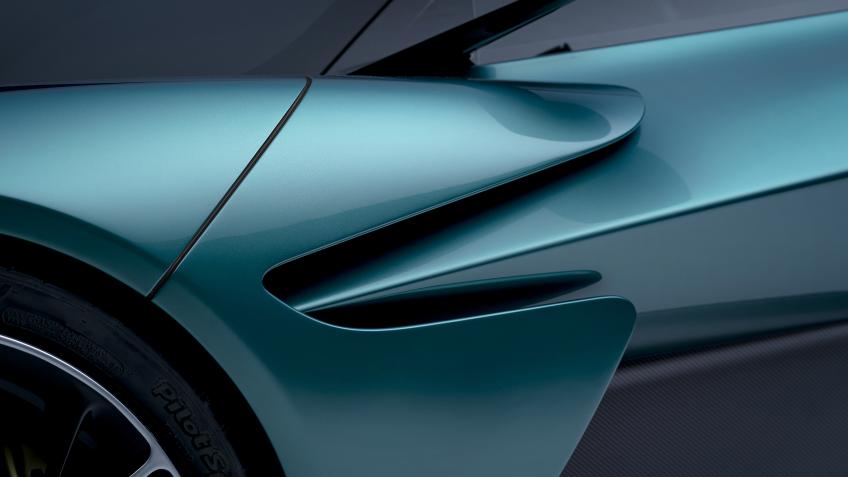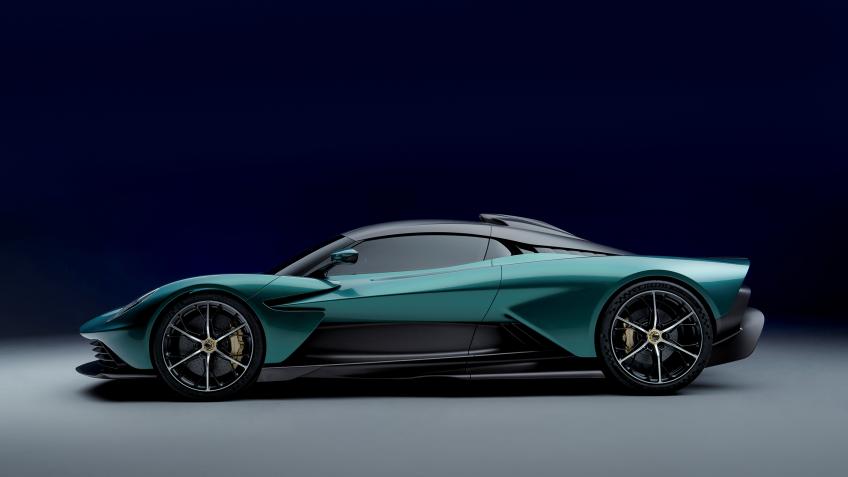Why door mirrors instead of cameras? Will a front numberplate wreck the aero? We ask Marek Reichman the big questions.

1. When the Valkyrie concept was first shown, we were told the green bits were for beauty and the dark bits were for aero. Is it the same here?
That was a simplified way of looking at the Valkyrie. But no, everything here is from my pen. Because of Valkyrie we now understand so much more around the laminar airflow around the lower aero.
There’s a lot more complexity down below in how we separate the air and send it to cool the big radiators and controlling the airflow off the back of the front tyre is really important. So it’s simplified from Valkyrie.
2. You obviously really know your stuff when it comes to aero. Did you learn all of this from working on the Valkyrie?
When you’re working with an R&D team, you have to use their language – in just the same way as when I say, ‘that surface needs more tension’ and I want the design team to know what I mean – I don’t mean tension of ‘I’m late for work’, I mean surface tension. How do you get the best from a team? You understand what the other parts of your team do.
I’m fascinated by aero anyway. A lot of my learning has come from sitting in Adrian’s office in Milton Keynes in the early days of Valkyrie just understanding how his brain thinks. I read some of his books!
And it goes way back – one of my favourite objects of all time is the Spitfire. Now aerodynamically it’s magnificent, but it’s beautiful as well, and if you look at the other planes of the time, they’re not as beautiful. No-one was doing CFD work then. It was just someone saying, ‘this is better’ and it was. I’ve always thought if something looks right, it’ll be right.

3. Is the front Aston grille purely cosmetic or does it have an aerodynamic job? And is it fixed or an active aero part?
Yes [it has a job], it splits and divides the air as it meets the car. I can’t tell you if it’s active or not…
I felt it more important when we left the realms of Valkyrie to have that [recognisable Aston cue]. Valkyrie is a unicorn.
You’ll hardly ever see one – it’s someone’s dream. Everyone wishes they had one, but it will be incredibly hard to live with.
Imagine if you go out on a drive on a bright sunny day and then it rains. You’ve got to stand on the seat to get in. Valhalla is about driveability and useability, so we add more things that make it recognisably an Aston.
4. Besides the grille, are there any other lines or details you can point to on the Valhalla that are inspired by classic Aston Martins?
There are always elements we take from our heritage – like the ‘S-curve’ above the front grille. You’ll see that on a DB5, or a modern Vantage.
I had so many arguments with Adrian Newey about having that detail on the Valkyrie because he didn’t want any of that, but then I reminded him he has a DB4 GT in his garage which has those lines, and he bought it for that very reason.
5. Why have you gone for door mirrors instead of cameras?
We have a camera system on the Valkyrie, but legislation determines you must put the screens where you’d normally look for a rear-view mirror. This constrains the interior design. When you do a Valkyrie design, it’s a shrink-wrap design. There isn’t half a millimetre to spare inside that car, let alone a millimetre. It’s an extreme design.
Here we have a little more freedom and the those for the Valhalla interior is to make a simple, calm, very pure environment. The feeling of having screens in a particular position just wasn’t right.
We talk to a lot of customers and they’re happy with [mirrors]. You can even use them to generate a bit more downforce.

6. Do you do most of your design work in the Red Bull F1 wind tunnel, or on a computer?
We do a lot in the wind tunnel, but we also make use of CFD (computational fluid dynamics) to manipulate surfaces, and the trick is actually how you interweave those learnings.
The F1 teams are expert in aero, while for road cars aero is usually just about stability. So it’s been about taking what we learnt with Valkyrie and adapting that [for Valhalla].
7. Where’s the boot? Will the front open up for luggage? And where does the charging cable live?
There’s a lot of cooling up front, but there’s some luggage stowage potential in the front, that will be a clamshell panel. Then you’ve also got some stowage inside, and there’ll be room for the charging cable on board.
8. Where does the front numberplate go?
The front numberplate will sit on top of the front radar detector. We learned from Valkyrie that the front numberplate actually helps with aero.
It causes the air to split and divides down the side of the car where you want it to go, where the cooling is, rather than heading towards the centre of the car where it’s not needed.

9. Have you sketched out what a Valhalla Spyder will look like?
What did Tobias (Moers, Aston CEO) say? ‘Too early to comment’, I think. But what I would say is it’s relatively simple when you have a carbon tub to create a spider.
10. How much has actually changed from the concept Valhalla?
If I were to park the two cars together, you’d see it’s a lot. The front is more muscular, the overhang is a little more shark-nose, the rear haunch is far more powerful. The snorkel was smaller at the top, and now the diffusers are greater, and the wing is now wider.
The wheelbase is slightly longer as the V8 is longer than the V6, and the cabin is pushed forward versus the concept.
11. So, a lot has changed. When we see the finished mid-engined Vanquish, will that have changed as much as this, or less, or even more?
More. In design and engineering. Vanquish will have evolved purely because of timing: these concepts were moments in time, and ultimately as a designer what you’re trying to do is make the object as relevant when it comes out as the first time you sketched it. And if you have the opportunity as we have with Valhalla and Vanquish – that’s its current name – times have changed.
This is how things are supposed to work. You take what you’ve learned on your hypercar and supercar, and that trickles down into the next, most affordable model.
Source: TopGear

